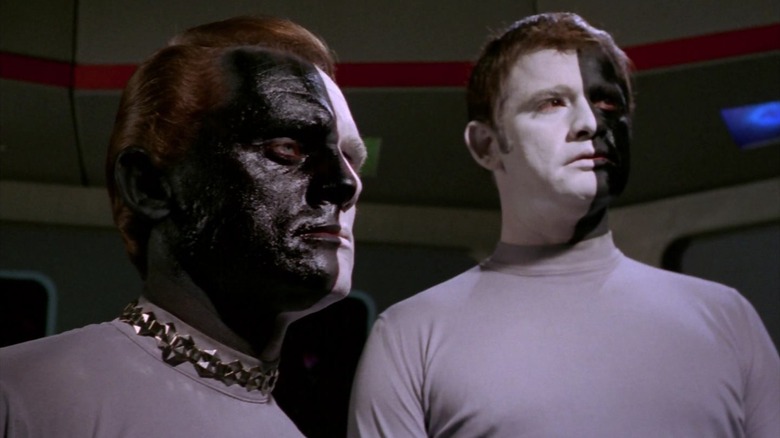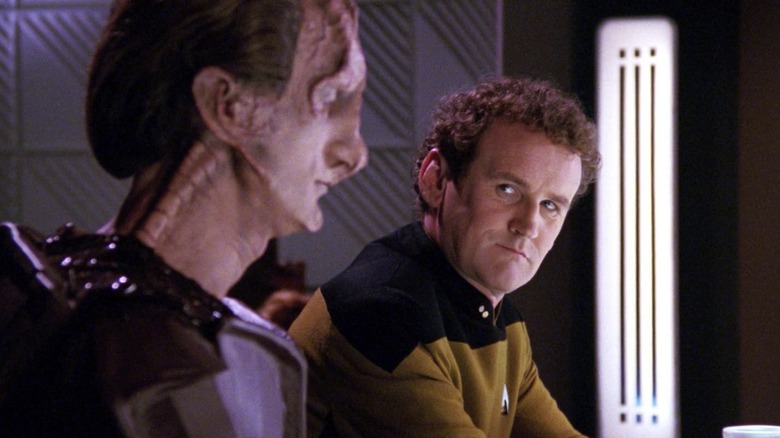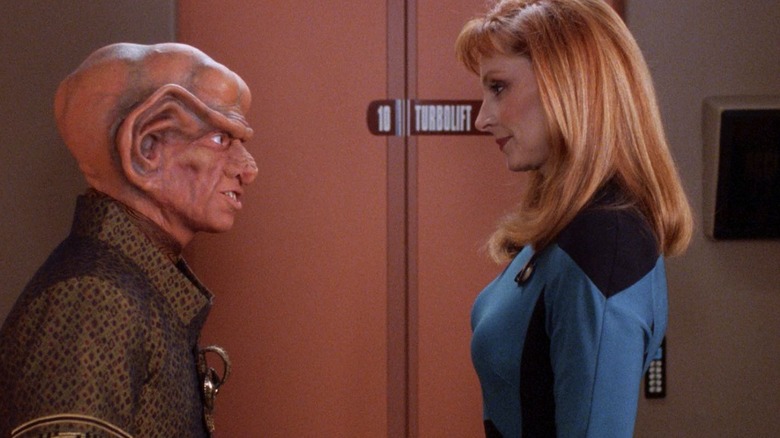How Star Trek Explored Prejudice Without Breaking Gene Roddenberry's Biggest Rule
On "Star Trek," the bridge of the U.S.S. Enterprise is, by design, racially and ethnically diverse. Show creator Gene Roddenberry invented "Star Trek" partly as a reaction to the turbulent world of the mid-1960s, hoping to create a utopian counterpoint to the horrors of war he witnessed on the news every day. By Roddenberry's reasoning, the future would be better than the present, as war would be brought to an end thanks to a concerted effort on humanity's part to unite. There are no national or racial divisions in Roddenberry's future, just a multicultural crew working together in harmony. Roddenberry essentially listened to John Lennon's "Imagine" and imagined it.
"Star Trek" was infamously taken off the air in 1969 but became a hit in reruns, becoming a cult phenomenon in the early '70s. "Star Trek" conventions began to pop up in big cities, and Roddenberry would often appear in person to discuss the themes and stories of his groundbreaking sci-fi series. It was during these discussions that Roddenberry, nicknamed the Great Bird of the Galaxy, became obsessed with his own utopian, post-prejudice ideas. By the time he was creating "Star Trek: The Next Generation" in 1986, Roddenberry had a new rule for his writers: no interpersonal conflicts. Not only was prejudice a thing of the past, but so too was interoffice bickering. Every Starfleet officer would get along all the time, dammit. The creator would make everyone get along.
This, of course, frustrated writers who required interpersonal conflicts to construct compelling dramas. The "Roddenberry Rule" was a good idea for the real world, but death in a writers' room. Also, if humanity was rid of all their racial and national prejudices, how would the writers pen topical stories with prejudice as their theme? Prejudice still exists in the real world, after all, and it would help the writers to write stories directly about it.
"Star Trek" adopted a clever workaround: The prejudices were only toward aliens.
Prejudice had to be against alien species
The Starfleet officers on "Star Trek" are all ostensibly enlightened folks, capable of interrogating their own personal weaknesses and overcoming any of their own neuroses or personal foibles. It would be inspiring to watch Starfleet officers overcome prejudices from time to time, as they were all wise enough to know, eventually, when they might be operating from a place of hate. Of course, for that to happen, they would require a few deep-seated prejudices to begin with.
This is where aliens come in. No one in Starfleet is ignorant enough to hate someone based on their race, their job, their age, their gender, their sexuality, or their station. Class is no longer an issue because "Star Trek" is set in a post-capitalist society. But when it comes to aliens, the human characters can be written as, at least temporarily, a little prejudiced. One can see interspecies racism all the time on "Star Trek." Dr. McCoy (DeForest Kelley) infamously mocked Spock's half-Vulcan heritage all the time. Kirk (William Shatner) admitted in "Star Trek VI: The Undiscovered Country" that he never trusted Klingons, especially after a Klingon killed his son.
The infamous episode "Let That Be Your Last Battlefield" (January 10, 1969) saw a pair of near-immortal aliens named Bele and Lokai (Frank Gorshin and Lou Antonio) who were half-white and half-black, bisected down the middle. They hunted each other for centuries merely because one of them was black on the right side and the other was white on the right side. That episode, quite obviously, was about the absurdity of prejudice.
That approach continued into the "Next Generation" days as well. Ferengis were all untrustworthy. Romulans were all devious. Klingons were all aggressive. Roddenberry and his writers hardwired some prejudices into his show, taking care that our stereotypes were only ever against aliens.
Despite everything, we learn to outgrow our prejudices
Of course, now that the prejudices were in place, the "Star Trek" writers set about overcoming them. Ferengi characters may have been described as untrustworthy, and Ferengi engaged in their share of dastardly behavior, but that didn't mean that all Ferengi were evil. Indeed, in the "Next Generation" episode "Suspicions" (May 9, 1993), Dr. Crusher (Gates McFadden) found herself boosting the research of a Ferengi scientist, and understood that Ferengi scientists are rarely respected by dint of their species. In "The Wounded" (January 28, 1991), Chief O'Brien (Colm Meaney) admitted that he hated Cardassians, but later had to admit it was because he associated the species with his war trauma. Prejudices could exist in "Star Trek," but they only existed to be overcome.
This interspecies prejudice, perhaps conveniently for the "Star Trek" writers, allowed them to skirt the lines of the no-interpersonal-conflicts rule. Starfleet officers were enlightened and always got along, but they could still have character flaws. Even the show's alien species protagonists followed the same pattern. Worf (Michael Dorn), a Klingon, expressed perplexity over his interactions with humans, but never noted that he hated or resented them. He was allowed to hate all Romulans because of longstanding cultural resentment. Worf was eventually forced to reconcile his feelings in "Birthright, Part II" (March 14, 1993).
To be sure, if O'Brien had to work with a Cardassian Starfleet officer, or Worf had to work with a Romulan Starfleet officer, their interpersonal conflicts would be deleted entirely. They are now equals in the workplace, and would respect one another.
So prejudice could still be a part of "Star Trek," and the Roddenberry Rule could remain intact. It's vital to note, though, that racist attitudes had no place on a Starfleet vessel. If you find you had prejudice, you will work to overcome it post-haste. I just wish Dr. McCoy had apologized to Spock at least once.


